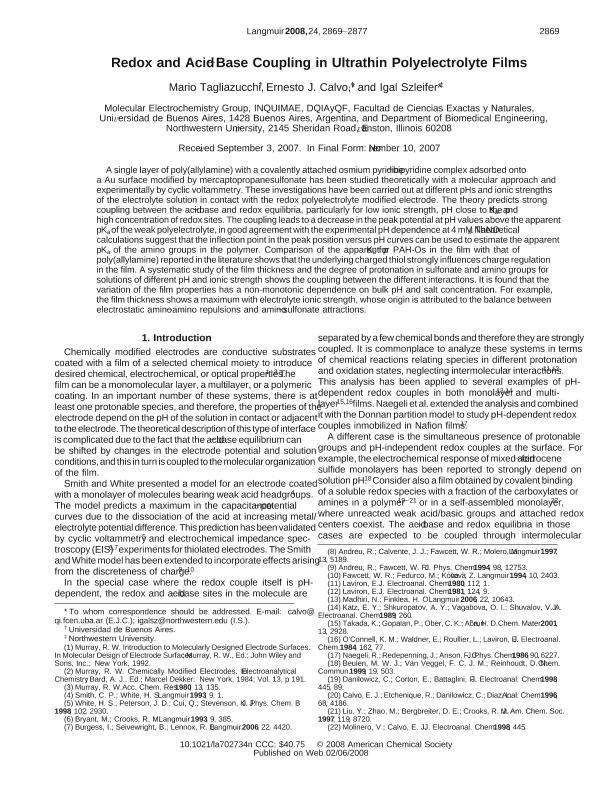Artículo
Redox and Acid−Base Coupling in Ultrathin Polyelectrolyte Films
Fecha de publicación:
03/2008
Editorial:
American Chemical Society
Revista:
Langmuir
ISSN:
0743-7463
Idioma:
Inglés
Tipo de recurso:
Artículo publicado
Resumen
A single layer of poly(allylamine) with a covalently attached osmium pyridine−bipyridine complex adsorbed onto a Au surface modified by mercaptopropanesulfonate has been studied theoretically with a molecular approach and experimentally by cyclic voltammetry. These investigations have been carried out at different pHs and ionic strengths of the electrolyte solution in contact with the redox polyelectrolyte modified electrode. The theory predicts strong coupling between the acid−base and redox equilibria, particularly for low ionic strength, pH close to the pKa, and high concentration of redox sites. The coupling leads to a decrease in the peak potential at pH values above the apparent pKa of the weak polyelectrolyte, in good agreement with the experimental pH dependence at 4 mM NaNO3. Theoretical calculations suggest that the inflection point in the peak position versus pH curves can be used to estimate the apparent pKa of the amino groups in the polymer. Comparison of the apparent pKa for PAH-Os in the film with that of poly(allylamine) reported in the literature shows that the underlying charged thiol strongly influences charge regulation in the film. A systematic study of the film thickness and the degree of protonation in sulfonate and amino groups for solutions of different pH and ionic strength shows the coupling between the different interactions. It is found that the variation of the film properties has a non-monotonic dependence on bulk pH and salt concentration. For example, the film thickness shows a maximum with electrolyte ionic strength, whose origin is attributed to the balance between electrostatic amino−amino repulsions and amino−sulfonate attractions.
Archivos asociados
Licencia
Identificadores
Colecciones
Articulos(INQUIMAE)
Articulos de INST.D/QUIM FIS D/L MATERIALES MEDIOAMB Y ENERGIA
Articulos de INST.D/QUIM FIS D/L MATERIALES MEDIOAMB Y ENERGIA
Citación
Tagliazucchi, Mario Eugenio; Calvo, Ernesto Julio; Szleifer, Igal; Redox and Acid−Base Coupling in Ultrathin Polyelectrolyte Films; American Chemical Society; Langmuir; 24; 6; 3-2008; 2869-2877
Compartir
Altmétricas




